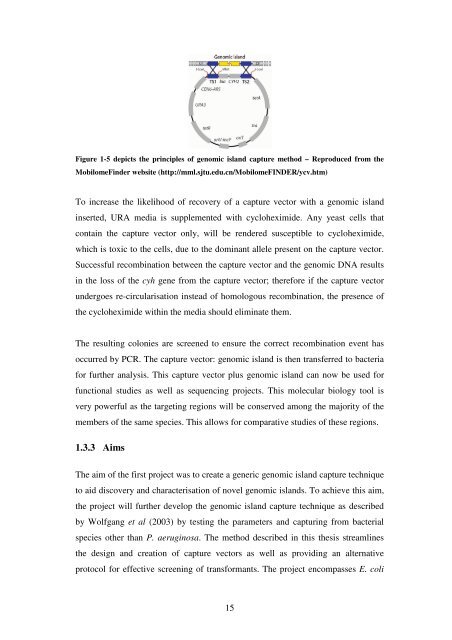5 The role of quorum-sensing in the virulence of Pseudomonas ...
5 The role of quorum-sensing in the virulence of Pseudomonas ...
5 The role of quorum-sensing in the virulence of Pseudomonas ...
You also want an ePaper? Increase the reach of your titles
YUMPU automatically turns print PDFs into web optimized ePapers that Google loves.
Figure 1-5 depicts <strong>the</strong> pr<strong>in</strong>ciples <strong>of</strong> genomic island capture method – Reproduced from <strong>the</strong><br />
MobilomeF<strong>in</strong>der website (http://mml.sjtu.edu.cn/MobilomeFINDER/ycv.htm)<br />
To <strong>in</strong>crease <strong>the</strong> likelihood <strong>of</strong> recovery <strong>of</strong> a capture vector with a genomic island<br />
<strong>in</strong>serted, URA media is supplemented with cycloheximide. Any yeast cells that<br />
conta<strong>in</strong> <strong>the</strong> capture vector only, will be rendered susceptible to cycloheximide,<br />
which is toxic to <strong>the</strong> cells, due to <strong>the</strong> dom<strong>in</strong>ant allele present on <strong>the</strong> capture vector.<br />
Successful recomb<strong>in</strong>ation between <strong>the</strong> capture vector and <strong>the</strong> genomic DNA results<br />
<strong>in</strong> <strong>the</strong> loss <strong>of</strong> <strong>the</strong> cyh gene from <strong>the</strong> capture vector; <strong>the</strong>refore if <strong>the</strong> capture vector<br />
undergoes re-circularisation <strong>in</strong>stead <strong>of</strong> homologous recomb<strong>in</strong>ation, <strong>the</strong> presence <strong>of</strong><br />
<strong>the</strong> cycloheximide with<strong>in</strong> <strong>the</strong> media should elim<strong>in</strong>ate <strong>the</strong>m.<br />
<strong>The</strong> result<strong>in</strong>g colonies are screened to ensure <strong>the</strong> correct recomb<strong>in</strong>ation event has<br />
occurred by PCR. <strong>The</strong> capture vector: genomic island is <strong>the</strong>n transferred to bacteria<br />
for fur<strong>the</strong>r analysis. This capture vector plus genomic island can now be used for<br />
functional studies as well as sequenc<strong>in</strong>g projects. This molecular biology tool is<br />
very powerful as <strong>the</strong> target<strong>in</strong>g regions will be conserved among <strong>the</strong> majority <strong>of</strong> <strong>the</strong><br />
members <strong>of</strong> <strong>the</strong> same species. This allows for comparative studies <strong>of</strong> <strong>the</strong>se regions.<br />
1.3.3 Aims<br />
<strong>The</strong> aim <strong>of</strong> <strong>the</strong> first project was to create a generic genomic island capture technique<br />
to aid discovery and characterisation <strong>of</strong> novel genomic islands. To achieve this aim,<br />
<strong>the</strong> project will fur<strong>the</strong>r develop <strong>the</strong> genomic island capture technique as described<br />
by Wolfgang et al (2003) by test<strong>in</strong>g <strong>the</strong> parameters and captur<strong>in</strong>g from bacterial<br />
species o<strong>the</strong>r than P. aerug<strong>in</strong>osa. <strong>The</strong> method described <strong>in</strong> this <strong>the</strong>sis streaml<strong>in</strong>es<br />
<strong>the</strong> design and creation <strong>of</strong> capture vectors as well as provid<strong>in</strong>g an alternative<br />
protocol for effective screen<strong>in</strong>g <strong>of</strong> transformants. <strong>The</strong> project encompasses E. coli<br />
15














